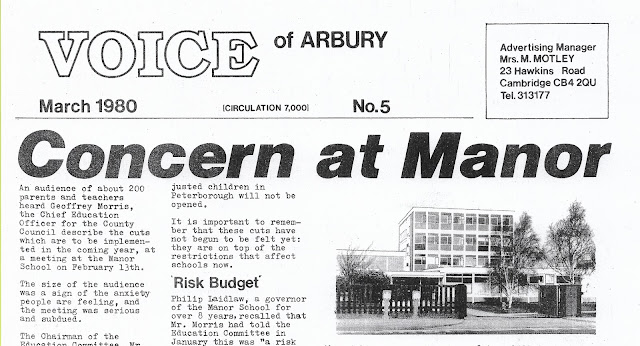'VOICE of ARBURY': In 1980, there was concern at Manor over class sizes at the Arbury schools, cutbacks, etc. In 1978, there was concern at Manor over possibly unlevel ears...
In the early months of 1978, cousin Sharon and her friend, Sharon, dropped David Soul and Paul Michael Glazer as their 'dishy' idols. They were gone forever - totally swept out by one John Travolta, who took the country by storm when Saturday Night Fever, a film released in the USA in late 1977, arrived here. I quite liked the soundtrack, but cousin Sharon was staying with us a lot and, having heard it about seven hundred times in one day (or so it seemed), I vehemently disliked it. Started climbing the wall every time she got her LP out.
Mind you, it was better than David Soul's Black Bean Soup.
The Manor had ceased to seem massive and now seemed like quite a dinky school. Familiarity!
1978 was a year of huge change for the school, as the headmaster, Mr Lewin, retired. He had been the original headmaster of the Manor Boys' School since it opened, and became headmaster of the new co-ed school at the start of the 1970s.
Miss Habgood, another member of the senior staff (I think she was head of the Lower School) and Miss Samuel, an art teacher since the early days, retired in 1978 too.
Mrs Firman, original headmistress of the girls' school, had become deputy head of the co-ed school when the school transitioned in 1970. She retired in 1980.
These stewards of the Manor since its earliest days seemed decidedly un-1970s to me, but there was no doubt the school had had a great reputation in the 1960s.
However, something was altering, and Manor and Arbury bashing were becoming all the rage in our lovely, caring, enlightened university city.
Meanwhile, as he became new headmaster, Mr Gaggs decided to do away with 'banding and streaming'.
This meant changes in the way our forms were organised. Mr Lewin had 'unashamedly' favoured and stuck with 'banding and streaming' pupils according to their judged academic ability, but Mr Gaggs opted to replace that system with mixed ability classes.
I think 1979 probably saw the implementation, but then the form designations changed and the 'A' for average, 'B' for below average and 'X' for excellent (as we always thought - not sure what it actually stood for really) were replaced by a system of Form 1.1, Form 2.1, Form 3.1, etc, up the school, simply designating the year and a form number (the number depending on yearly intake pupil numbers - my year had eight forms, but the birth rate was tumbling).
My form went from being 3A1 (if I remember rightly) to 3.7.
I had other worries in 1978. I became a teenager, and was highly disappointed. The first signs of 'growing up' (at least physically) had kicked in when I was eleven, and by the time I turned thirteen I was a spotty Herbert, with an increasingly gruff voice, and the beginnings of a fine downy beard around my jowls and chin. Turning thirteen, becoming a teenager, was not the beginning of a wonderful new phase of my life.
Same old scene, in fact.
I kept a diary years before Adrian Mole, and certain incidents I may have forgotten (some I may have been better off forgetting) are recorded in its pages.
Here's a choice example:
I was standing by the tower block one day. It was the lunch hour, and I was waiting for my mate Michael who'd gone to the loo, when a girl from my year came over for a chat.
She was a good natured girl, but she didn't half talk a lot, and she tended to say exactly what she thought. There was never any malice, but there was never any tact either.
She talked a lot, usually along the lines of: 'I really want a horse. I wish I lived in the country. Is Karen still off sick? Here, was that you at the Adventure Playground getting told off last night? You haven't been smoking, have you?'
You'd have time to insert brief answers and then she'd be off again.
On this day, she ended with something like: 'I'm going to Bury St Edmunds on Saturday. Buying shoes for Julie's wedding.' Then something suddenly seemed to strike her, and her eyes widened: 'Here, your ears aren't level! Did you know?'
'Don't be daft!' I said (or something similar).
'They're not!' she insisted. 'Here, Carol, come and look at Bretty's ears! Not level, are they?'
Carol, who'd been on her way to the dining hall, came over to look at this fascinating oddity.
'Not sure,' she said, finally. 'They don't look quite right, but he's dead ugly anyway!'
Michael emerged from the loos, and before my ear-assessing panel could enlist him, I said: 'Come on, mate, let's get out of here!'
How ridiculous! I thought. Never heard anything so stupid in my life!
But after lunch I went to the loos and looked anxiously in the mirror. Surely, one ear was just slightly lower than the other? Or was it just the dodgy, dirt cheap haircut?
When I got home, I checked again and, yes, one ear definitely seemed to be lower. Only a bit, but...
By the time a week had passed, I was convinced there was at least a two inch difference between my ear levels - and it was growing fast. I began to hold my head on one side during conversations, hoping people wouldn't notice.
Then my hair grew and I could hardly see my ears and a large zit appeared on my nose and I stopped worrying about my ears and started worrying about that.
Ah, the joys of teenagehood!


Comments
Post a Comment